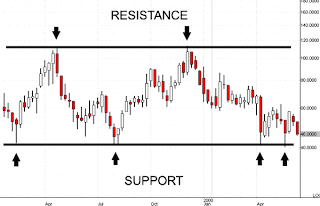It's important to know when, where and who to fight, as well as knowing how to fight. But the most important thing to know is when not to fight!!
There's no point in learning all the techniques required to win a battle if you then take on the wrong opponent. It's a bit like trading GBP/USD instead of GBP/JPY. Although they move very similarly, they can be very different and they have mastered different forms of fighting back...
There are a number of scenarios where it's inadvisable to trade. These can be separated into personal/environmental reasons and market reasons.
Personal reasons not to trade:
1.
Do not trade while drunk. You need a clear head while you are trading. You would not fight an opponent while drunk. In fact, you might think you were fighting 2 opponents if you did!! Drinking can affect your state of mind in so many ways and can make you make simple mistakes while trading. Many of these mistakes would not be made if you were sober.
2.
Get rid of all distractions. You need to be able to concentrate on the charts and not get caught up with other things going on. For instance you might be waiting for a trade and then you get distracted and when you come back to your chart you have missed the trade or you buy instead of selling etc. Distractions can be costly. However, life is full of distractions so put the cat in the hall and shut the door. Put the baby in the playpen where you can see/hear her but at least you won't have to worry that she has wandered off again... Whatever your potential distractions are, deal with them before you start to trade. Even a Ninja can lose a fight if distracted...
3.
Emotional times. If something emotional has happened, and you can't be subjective, then do not trade! This could be any number of things that had a negative impact on your day. It could be that you broke up with your partner to a death in the family etc... You need to be able to assess what's happening in a very short period of time, and if you are mentally elsewhere then this can have a negative impact on your trading account...
The personal times that you shouldn't trade can really be summed up as times when you are out of synch with your normal body rhythm. These are times where your emotions or environment can negatively affect the way you trade, and can seriously hamper the likelihood of a successful trade. The good news is these tend to be things that you can control or have some degree of control over. The market reasons for not taking a trade are a bit different. These tend to be external where you have very little or no control over them. These can really kick you in the butt and leave you limping for a while. Ignore these at your Peril!!
Market Reasons not to trade:
1.
Bank Holidays. These are scheduled and there is nothing you can do about it. If there is an USA or UK Bank Holiday I don't bother trading. This is because the Banks are the biggest participants in the Forex market. If they are on holiday then the volume of transactions being carried out is greatly reduced. This can lead to either really static markets or on occasion erratic markets. Either way it does not follow the normal pattern, so I stay clear.
If however, it's a Bank Holiday in another country such as Japan or Australia then I wouldn't trade currencies that belong to those countries, e.g. jpy or aud pairs, but would still trade the gbp/usd/chf etc pairs...
2.
News. There are scheduled news releases, and economic news, that is due to be released throughout the day. These can be found, in advance, in a number of places but the most popular one seems to be the Forex Calendar, provided by Forex Factory.
There are 3 types of news; yellow, orange and red. Each has a different impact and is all explained in the calendar. There tend to be folders that generally are not a good idea for a new trader to try and trade. High impact, red folders, can really move the market, sometimes spiking in both directions, before settling done. These are high risk times where a lot of people get stopped out.
The one's I specifically avoid would be the ISM Manufacturing data, interest rate announcements and NFP related news announcements. However, it's not just the announcements themselves that can affect the market. The rumours surrounding what the potential numbers will be can cause the markets to move in anticipation. Therefore, it's not a good idea to trade, for the hour before or after the news. With NFP, it's a good idea not to trade that day at all.
Now that may seem extreme, but these can be the biggest account killers and can wipe out a new account in a few seconds.
3.
Speeches. These tend to generally be on the calendar as well. If specific people are talking then please do not trade. These people include the ECB President Jean-Claude Trichet, Fed Chairman Ben Bernanke and BOE Governor Mervyn King. It's important that when the BOJ Governor Masaaki Shirakawa speaks to pay attention. These tend to happen when people are asleep so less of a worry. But if you are trading the Japanese session then be wary!!
These people are notorious for dropping hints about economic policy changes that are likely to happen with the currency they are responsible for. These hints cause a lot of speculation in the market and therefore a lot of price movement. These can be big currency movers as they are generally responsible for setting Interest rates in those countries, and as mentioned above interest rate announcements can cause large movements.
4.
Erratic Periods. There will be times where a currency is moving differently from normal. Perhaps it's spiking and you don't know why. This is a good time to stay out of the market. If you don't understand why it's moving like this then it's generally because there is unscheduled news that has been released or leaked. This is generally bad news and the market is still unsure as to how to react to it. For instance, this was happening during the recent credit crunch and the various Banks reporting that they were having major difficulties.
5.
Weekends. It's unadvisable to hold trades over the weekend, unless your method is a long term strategy which specifically involves holding trades for longer time frames, such as weeks or months.
A lot can happen over the weekend. All it would take is for 1 Bank to go bust over the weekend for your position to go completely different from how you expected... A terrorist attack could happen over the weekend, which would also move the markets crazily. Now these might seem out of the norm but if you look these have happened recently on more than 1 occasion.
These types of events will generally lead to the market opening again will a large gap and generally with a large change in your position. A lot of times this can cause serious harm to your trading account balance.
6.
Market close/open. Good idea to avoid these or be wary around these times. At market close a number of trading positions are being closed. This will lead to volatility in the currency markets and can cause the price to move erratically. The same applies at market open. A lot of people are opening positions as they do not want to hold them over the weekend for the reasons stated above.
7.
December and Summer Holidays. Banks tend to trade the Forex markets at least once a day for balance sheet reasons and can also trade a number of times throughout the day for speculation reasons.




























